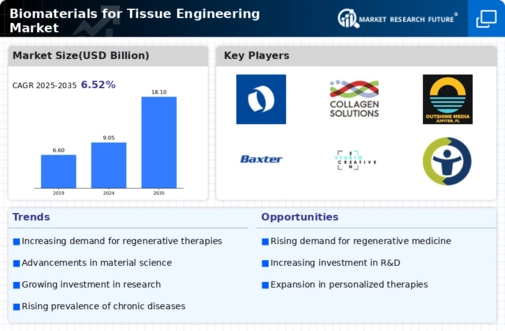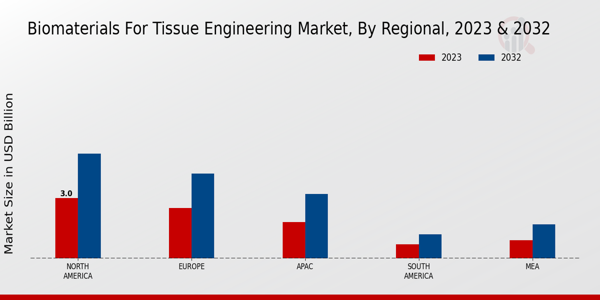Market Growth Projections
The Global Biomaterials for Tissue Engineering Market Industry is projected to experience substantial growth over the next decade. With a market value expected to reach 9.05 USD Billion in 2024 and further expand to 18.1 USD Billion by 2035, the industry is poised for a robust trajectory. The anticipated compound annual growth rate (CAGR) of 6.53% from 2025 to 2035 reflects the increasing adoption of biomaterials in various medical applications. This growth is driven by advancements in technology, rising healthcare demands, and a greater understanding of biomaterial interactions with biological systems.
Growing Prevalence of Chronic Diseases
The rising incidence of chronic diseases globally is a critical factor influencing the Global Biomaterials for Tissue Engineering Market Industry. Conditions such as diabetes, cardiovascular diseases, and orthopedic disorders necessitate advanced treatment options, including tissue engineering solutions. As healthcare systems strive to address these challenges, the demand for biomaterials that can facilitate tissue regeneration and repair is expected to increase. This trend underscores the importance of biomaterials in developing effective therapies, thereby propelling market growth. The ongoing need for innovative solutions to manage chronic diseases reinforces the relevance of biomaterials in modern medicine.
Rising Demand for Regenerative Medicine
The Global Biomaterials for Tissue Engineering Market Industry experiences a notable surge in demand due to the increasing focus on regenerative medicine. This sector aims to restore or replace damaged tissues and organs, which is becoming increasingly relevant as the global population ages. For instance, the market is projected to reach 9.05 USD Billion in 2024, reflecting a growing recognition of the potential of biomaterials in therapeutic applications. The integration of biomaterials in regenerative medicine not only enhances healing processes but also improves patient outcomes, thereby driving further investment and innovation in this field.
Regulatory Support and Approval Processes
Regulatory frameworks play a pivotal role in the Global Biomaterials for Tissue Engineering Market Industry. Supportive regulations and streamlined approval processes for new biomaterials encourage innovation and facilitate market entry for novel products. Regulatory bodies are increasingly recognizing the importance of biomaterials in healthcare, leading to more favorable conditions for research and commercialization. This regulatory environment not only enhances the confidence of investors and manufacturers but also accelerates the development of safe and effective biomaterials for tissue engineering applications. Such dynamics are likely to contribute to the overall growth of the market.
Technological Advancements in Biomaterials
Technological innovations play a crucial role in shaping the Global Biomaterials for Tissue Engineering Market Industry. Advances in material science, such as the development of bioactive and biodegradable materials, enhance the functionality and applicability of biomaterials in tissue engineering. For example, the introduction of 3D printing technology allows for the creation of complex tissue structures that closely mimic natural tissues. This evolution is expected to contribute to the market's growth, with projections indicating a compound annual growth rate (CAGR) of 6.53% from 2025 to 2035. Such advancements not only improve the efficacy of treatments but also expand the range of applications for biomaterials.
Increased Investment in Research and Development
Investment in research and development is a significant driver of the Global Biomaterials for Tissue Engineering Market Industry. Governments and private entities are increasingly funding projects aimed at exploring new biomaterials and their applications in tissue engineering. This influx of capital fosters innovation and accelerates the development of novel solutions for tissue repair and regeneration. As a result, the market is anticipated to grow substantially, reaching 18.1 USD Billion by 2035. The focus on R&D not only enhances the understanding of biomaterial interactions with biological systems but also paves the way for breakthroughs in clinical applications.
























